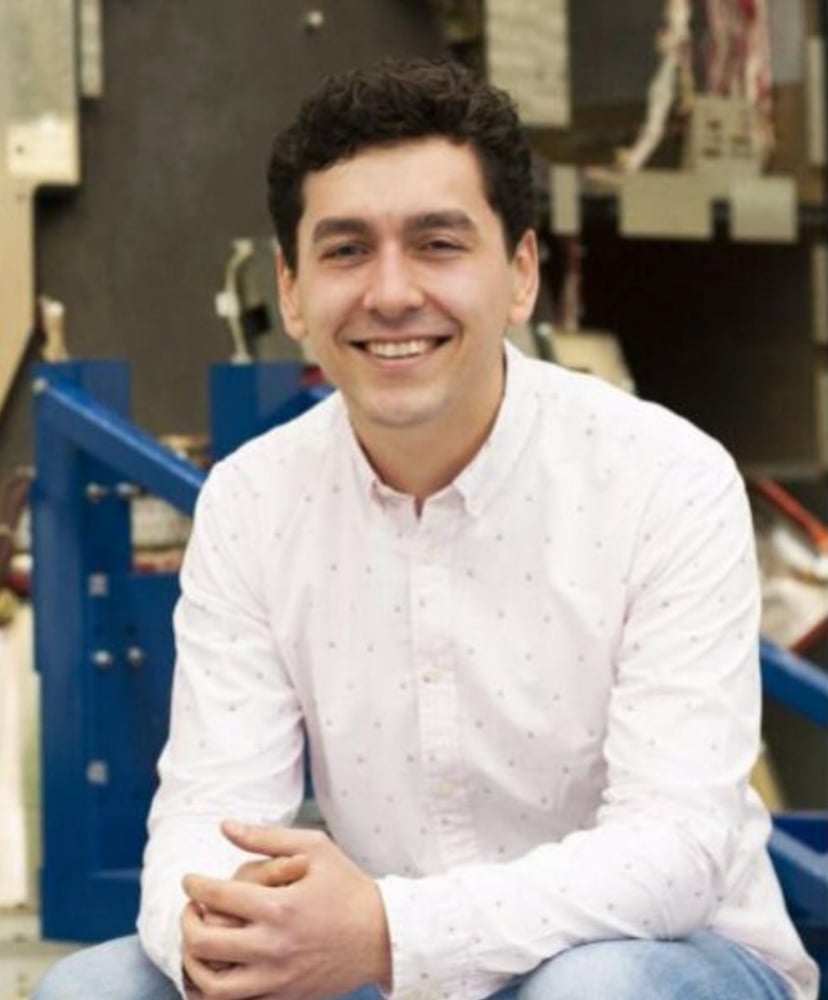Today we will talk about aircraft noise and different aspects around this topic. We have with us a guest from the Netherlands Robert Coster, the founder of Aerlabs. So Robert welcome. Could you tell us a bit about yourself and give us a brief introduction about what is the main focus of your company which are the pain points of the aviation industry you resolve and address?
Well, thank you Elena. My name is Robert and my background is in aerospace engineering from Dallas University of Technology. I'm graduated in the field of aircraft noise and climate effects and did my thesis on the difference between aircraft noise modeling and measuring. I started Aerlabs because I have a passion for software engineering and that's what we do at Aerlabs. We combine both software engineering and aerospace engineering to solve problems in the aviation industry. Our first product was is called Echo. With Echo, we help people model the aircraft noise effects of operational choices. So think of a new route designs or preferential runway systems or different operating procedures. All those things can be modeled using our own model, and that's what we try to focus on. We try to focus on giving people the tools to assess improvements in their operation to minimize the impact of noise.
Right. That sounds really interesting. So going back to the topic today, I would like to ask you what on your opinion is the impact of aircraft noise and also emissions in general on aviation, airports, air routes?
Well, I think the impact is very big of noise and emissions in general because of course with global warming we see that we need to do something about the emissions of aviation. But that aside, the noise impact is also very important because we have seen that air traffic is increasing the airspace is getting busier and busier. The amount of people living nearby the airport is also increasing. So we need to balance those two and make sure that we don't increase the amount of people being annoyed and affected by noise. There has been research in the past where there is the effect of noise on people with heart diseases and other things. It can have serious health consequences to have the aircraft noise. So yeah, that's a big issue and we need to make sure that we try to limit the noise effects.
I totally agree with you here. And if we look globally, what's the picture in regards to noise? Where is the noisiest from your experience?
Well, we have been working primarily here in the Netherlands and near Europe. So if I'm correct, it's a European environment agency, which has a report on the noise situation in every city Europe. And they concluded that in Berlin, Lisbon, London and Luxembourg, there is the highest proportion of people exposed to aircraft noise. So in a way, those are the places to avoid when you are searching for a home that isn't affected by aircraft noise that much.
Right. Also, I think it depends on the geographic location, isn't it? And a lot of factors, it's not the same everywhere. So how is the noise measured? Do you install microphones or do you base the measurements on flight paths?
Well, at Aerlabs we do noise modeling, which primarily uses flight paths to and all the other characteristics such as the aircraft type of operation those kinds of things to model the aircraft noise. So we don't do any measurements regarding noise itself, but normally you would use measurements and that's what a lot of airports have and provide information to the community about the noise measurements. And that's all done with microphones positioned on very large poles to have a very objective measurement of the noise situation.
And when you do the modeling, is it used then to apply different mitigation measures to reduce noise?
Yes. So typically you would have two types of aircraft noise assessments. You have the historic noise assessments where you try to model as realistically as you can off the past situation, but you'll also have the predictive calculations, which are more focused about creating a prediction of the future and assessing what the noise impact will be of all those decisions that are made for that future. On the one hand side, that can be as simple as we expected - air traffic to grow with 10%, what will the noise impact be? On the other hand, that can also be something like, okay, we have the current procedures, what if we change the procedure? Will it affect the people living below that route, for instance, and how will it change? So that's what we try to focus on those studies where we're actually looking to improve the situation.
And if we talk about noise mitigation measures we know that airports and ANSPs are doing activities in this area. Could you talk from your experience what were the mitigation measures that you had to deal with or which ones you think are the best?
Well, in general, we used the ICAO balanced approach. Most of the stakeholders in the aviation industry are using the ICAO balanced approach, which basically says, let's first look at the reduction of noise at the source to mitigate issues related to noise. Then they add land use and planning, which basically means that you try to avoid people from living in the areas that are heavily affected by noise. Then you are going to noise abatement operational procedures, for instance, a CDO or takeoff procedures that have been developed to minimize the noise impact. And as a fourth step, you have operating restrictions which basically mean that there is a night curfew or certain types aren't allowed at certain airports because they are too noisy. And in general, I like that approach, especially focusing on reduction of noise at the source. But what we see in Europe is that we need to put everything together. We can't do it in a phased approach where we start at the top and work towards the bottom, but only if necessary. We have to take measures on every aspect to limit the amount of noise that we produce around the airports. But personally, I see that especially with the operational procedures, there is a lot that can be done and we need to keep doing to improve noise situation, for instance, think of a performance based navigation, those kinds of measures to really be in control of the amount of noise that is created around the airport.
Okay, very, very nice. There's a very interesting aspect about perceived noise versus a real noise. For example, sometimes people see an aircraft and when they automaticly see it, they think it's noisy, even if it's at a very high altitude. Which insights can you bring about it from your experience?
Well, what we typically try to do when measuring or calculating aircraft noise, we use what we call a weighted noise levels, which is a measure of the amount of noise that we perceive as human. And the nice thing about those metric is that we can both measure it and calculate it, which gives a very objective view on the amount of noise that object produces. However, if we think about those noise levels, we are putting it in a number, but that doesn't say something about the perception, like how you hear it, and if you really get annoyed by it. So there's a psychological aspect to noise. And what we typically do, and that's a big limitation of what we do in aircraft noise modeling in my opinion, is we try to focus on those numbers and then we compare them with background noise levels. So let's say there is a background noise in an urban area, 40 decibels, then we say, well, if it doesn't surpass that 40 decibels, then we're fine because the aircraft noise isn't noisier than background noise that we typically hear in that urban area. However, if you would stand in that location with 40 decibels of background noise, you would still be able to hear it because you don't hear the amount of noise, you hear certain tones like certain characteristics in the noise. And that's also why if you are aware of it, then you try to hear it and then you try to put your attention there. So it's if you're already annoyed by the aircraft and if you already know that you're like, if you're biased in that, you will focus on it much more and it will be much more annoying than when you wouldn't be aware of it in the first place because it doesn't surpass that threshold. But yeah, that's kind of the difficult thing with aircraft noise is that we try to put things in number just to make sure that we can act on it. But on the other hand, the psychological aspect is very complex too.
Yeah, our interesting human nature.
And now if we look at drones, there is a lot going on in this niche, but do we really give it a real thought because drones are going to fly much lower than the airplanes and it is going to be noisy. So what is your stand here? Do we really want to have more noise above us where cities are already noisy?
I think we should be very cautious in moving forward in this area, or at least we should put our efforts in understanding a bit better what the impacts will be on people living in those areas where drones will be flying. Because if I look at everything that's happening in UTM, I think there are a lot of interesting developments because I'm aerospace engineer too. So those hardware that's being made for this, the operational concepts, et cetera, I, I'm really excited about it, especially the automated part of UTM. However, we do have to think of the same issues that we have with normal ATM such as noise, and we need to think of the impact that we have in that area because as you said, aircraft are flying much lower and we need to think a bit further than do we have segregated airspace or do we have unsegregated airspace and how are we going to organize it in the airspace, but also think of, okay, but if the amount of traffic increases, we do not only need to think about capacity of the airspace and safety aspects, but also will people be affected.
Because just the other day, a small drone was flying over my house and we were sitting in the backyard and we were just annoyed by the amount of noise that like the zooming and noise that small drone provided. And I'm a bit scared that if we don't think about how we are going to mitigate those issues right now, as we see drone unmanned aerial systems, if such a drone is flying over your house, it's already noisy. And we need to think of how are we going to make drones operational, and under which conditions are we going to allow those drones to fly because we are only thinking about the operational concepts, efficiency, capacity, safety, but we also need to take that into accounts to make sure that people aren't much more annoyed by drones compared to normal aircraft operation.
Yeah, it's definitely the case because were, when we see things related to drones, they cover all the aspects, but noise most of the time is ignored. So it's an interesting aspect to look at. And also talking about the time we are still affected by the pandemics, there is less noise as aircrafts are flying less, but how will noise sensitivity increase when the traffic restarts?
Well, I think in general that's again, a bit the psychological aspect of Covid pandemic is that we are a bit used to quiet surroundings because there is a lot less happening on the streets and we are staying at home, we're not going to work every day. So people are getting used to those quiet surroundings. And I think once the pandemic is over, we start to get more busy in moving to the office and going to parties. And of course aircraft, they start to move again. And what we will see is, or at least that's my expectation, is that the surroundings get louder, louder and louder. And aircraft noise is just one of them, but the surroundings get louder and we will have to get used to that again than what we currently are. So I think that's what we should be aware of, that people are maybe a bit more annoyed by aircraft noise once the aircraft are flying more and more and recovering from the pandemic. So airports and authorities getting all those complaints should be expecting more.
Right. And so this topic about noise is complex, but interesting also because it's related to our human nature. And now looking at the evolution of UTM, but also ATM, how do you see this evolving in the next five years, but also in the next 50 years? What would be your stand here?
I think that, I mean, traffic will grow and it will grow very fast. I think if it takes off, it goes very fast. So although we will start small, we see that with the surveillance and measuring of drones, it will get more and more popular. So we have to expect growth from both the amount of drone traffic and well the normal commercial traffic. And what I think is that in terms of noise mitigation measures in five years, we will make it more important in designing operational procedures. So traditionally designing procedures is a lot very much focused on capacity ATC workload, those kinds of traditional metrics on airspace performance. But I think especially in the TMA noise and environmental indicators will be much more important on assessing the performance of the airspace. So that's what I think that will happen in the next five years, that it will definitely be a very standard part of the design process for procedures.
What would you like to see, or how would you imagine it being?
Well, I expect much more whereas with the climate change in 50 years, things will look a lot different. I think being energy neutral is the bigger thing also in aircraft, because aircraft has long lifecycles. And I think in 50 years we can have very different aircraft compared to what we see today because there is a very big need of getting those improvements. On the environmental aspect, think of a flying V that has been developed by or that is currently under research from DelftUniversity of Technology because it has a lot of improvements in terms of flight efficiency. So I expect the aircraft to look different in 50 years, but I also expect more automation, more automation and supervised automation in the airspace because the air traffic will definitely grow. And in order to account for that, we cannot just add more air traffic controllers. We need to be able to give the air traffic controllers more tools to manage the increased capacity. And in terms of drones, I expect a lot from swarm intelligence there, in UTM too. So that will also allow us to have those automatic trajectory optimizations and making sure that noise is limited, environmental effects are limited, those kinds of things. I think they will be a standard in 50 years. So I expect it to be properly managed in 50 years.
Right, right. Robert, it was really, really nice talking to you. Thank you so much for being our guest, for sharing your opinions. We wish you a lot of success in your activities.




